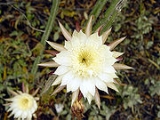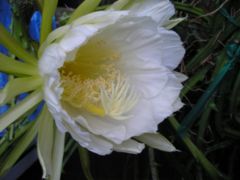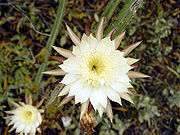
Moonlight cactus
Encyclopedia
Moonlight cacti, genus
Selenicereus, is an epiphytic
, lithophytic
, and terrestrial cactus
genus found in Central America
, the Caribbean
and northern South America
.
), the Greek moon goddess, and cereus, meaning "candle" in Latin
, referring to the nocturnal flowers. The term nightblooming cereus
is sometimes used here, but this is also used for many night blooming cacti, including Epiphyllum
, Hylocereus
and Peniocereus
.
Genus
In biology, a genus is a low-level taxonomic rank used in the biological classification of living and fossil organisms, which is an example of definition by genus and differentia...
Selenicereus, is an epiphytic
Epiphyte
An epiphyte is a plant that grows upon another plant non-parasitically or sometimes upon some other object , derives its moisture and nutrients from the air and rain and sometimes from debris accumulating around it, and is found in the temperate zone and in the...
, lithophytic
Lithophyte
Lithophytes are a type of plant that grows in or on rocks. Lithophytes feed off moss, nutrients in rain water, litter, and even their own dead tissue....
, and terrestrial cactus
Cactus
A cactus is a member of the plant family Cactaceae. Their distinctive appearance is a result of adaptations to conserve water in dry and/or hot environments. In most species, the stem has evolved to become photosynthetic and succulent, while the leaves have evolved into spines...
genus found in Central America
Central America
Central America is the central geographic region of the Americas. It is the southernmost, isthmian portion of the North American continent, which connects with South America on the southeast. When considered part of the unified continental model, it is considered a subcontinent...
, the Caribbean
Caribbean
The Caribbean is a crescent-shaped group of islands more than 2,000 miles long separating the Gulf of Mexico and the Caribbean Sea, to the west and south, from the Atlantic Ocean, to the east and north...
and northern South America
South America
South America is a continent situated in the Western Hemisphere, mostly in the Southern Hemisphere, with a relatively small portion in the Northern Hemisphere. The continent is also considered a subcontinent of the Americas. It is bordered on the west by the Pacific Ocean and on the north and east...
.
Description
Clambering plants with flat to angled stems, producing aerial roots. Areoles may be with or without spines. Flowers are large and nocturnal, pollinated by moths or rarely bats. The receptacle bears small bracts, hairs and usually spines. Fruits bear numerous spines. Flowers are generally produced in abundance with mature plants and are typically white and are very fragrant and only last a single night in most species.Etymology
The generic name is derived from Σελήνη (SeleneSelene
In Greek mythology, Selene was an archaic lunar deity and the daughter of the Titans Hyperion and Theia. In Roman mythology, the moon goddess is called Luna, Latin for "moon"....
), the Greek moon goddess, and cereus, meaning "candle" in Latin
Latin
Latin is an Italic language originally spoken in Latium and Ancient Rome. It, along with most European languages, is a descendant of the ancient Proto-Indo-European language. Although it is considered a dead language, a number of scholars and members of the Christian clergy speak it fluently, and...
, referring to the nocturnal flowers. The term nightblooming cereus
Nightblooming cereus
Nightblooming Cereus is the common name referring to a large number of flowering cereus cacti that bloom at night. Because of the short life of the flowers, the nightblooming cereus has a romanticized reputation and has given rise to erroneous beliefs, such as that the plants bloom only once a...
is sometimes used here, but this is also used for many night blooming cacti, including Epiphyllum
Epiphyllum
Epiphyllum is a genus of 19 species of epiphytic plants in the cactus family , native to Central America. Common names for these species include orchid cacti and leaf cacti, though the latter also refers to the genus Pereskia....
, Hylocereus
Hylocereus
Hylocereus is a genus of cacti, often referred to as nightblooming cactus . Several species have large edible fruits, which are known as pitaya or dragonfruits.-Taxonomy:...
and Peniocereus
Peniocereus
Peniocereus is a genus of vining cacti, comprising about 18 species, found from the southwestern United States and Mexico. They have a large underground tuber, thin and inconspicuous stems.-Synonymy:...
.
Species
| Species | Description | Image |
|---|---|---|
| Selenicereus anthonyanus Selenicereus anthonyanus Selenicereus anthonyanus is a cactus species native to southern Mexico. It is grown as an ornamental because of its beautiful nocturnal flowers and unusual stems.-Etymology:... (Alexander) D.R.Hunt |
Mexico. Stems like those of Epiphyllum anguliger Epiphyllum anguliger Epiphyllum anguliger, commonly known as the fishbone cactus, is a cactus species native to Mexico. The species is commonly grown as an ornamental for its beautiful, fragrant flowers in the fall.-Etymology:... but more vining and with short spines. Flowers ca. 12 cm long, 10–15 cm wide, the outer inner tepals purplish, the inner cream. |
 |
| Selenicereus atropilosus | Mexico. Flowers 12 cm long, receptacle with black hairs. The species is close to some species in the genus Weberocereus Weberocereus Weberocereus is genus of cacti. It produces a green and white flower and is found mainly in Costa Rica and Nicaragua.-Synonymy:The following genera have been brought into synonymy with Weberocereus:*Eccremocactus Britton & Rose... |
|
| Selenicereus chrysocardium | Mexico. Stems deeply lobed, ca. 28 cm wide. Flowers 32–38 cm long, 23–30 cm wide, base of receptacle very spiny. The species is close to the genus Epiphyllum Epiphyllum Epiphyllum is a genus of 19 species of epiphytic plants in the cactus family , native to Central America. Common names for these species include orchid cacti and leaf cacti, though the latter also refers to the genus Pereskia.... . |
|
| Selenicereus grandiflorus Selenicereus grandiflorus Selenicereus grandiflorus is a cactus species originating from the Antilles, Mexico and Central America. The species is commonly referred to as Nightblooming Cereus, Queen of the Night , Large-flowered Cactus, Sweet-Scented Cactus or Vanilla Cactus. The true species is extremely rare in cultivation... (L.) Britton & Rose |
Jamaica, Cuba; Guatemala, Honduras, Nicaragua. Stems many-ribbed. Flowers 18 cm long, receptacle densely woolly. Three subspecies are recognized: ssp. grandiflorus ssp. donkelaarii - Mexico. Stems 1 cm thick, low-ribbed, spines short, appressed to stem. Flowers 18 cm long. ssp. hondurensis- Honduras? Stem ribs tubercled. Flowers 30–34 cm long. |
|
| The following species are very closely related to each other and possibly better treated as synonymous taxa or subspecies. | ||
| *Selenicereus boeckmannii | Cuba, Haiti, Dominican Republic, Mexico. Flowers 24–39 cm long. Close to S. pteranthus. | |
| *Selenicereus brevispinus | Cuba. Spines less and 1 mm long. Flowers 25 cm long. A shortspined S. grandiflorus. | |
| *Selenicereus coniflorus (Weing.) Britton & Rose |
Mexico. Stems thick, usually with 5-6 ribs, spines to 1,5 cm long. Flowers 22–25 cm long. A long spined S. pteranthus or few ribbed S. grandiflorus. | |
| *Selenicereus hallensis | Colombia? Only known in cultivation and possibly a hybrid with S. macdonaldiae and some other "species". | |
| *Selenicereus urbanianus | Cuba, Haiti, Dominican Republic. Stems 4-5-ribbed, flowers 20–30 cm long. | |
| Selenicereus hamatus Selenicereus hamatus Selenicereus hamatus is a species of Cactaceae and produce one of the largest flowers in the family. It is a cultivated ornamental vine. The species is native to Mexico.-History:... (Scheidw.) Britton & Rose |
Mexico. Stems 3-4-ribbed, with knobby projections, nearly spineless. Flowers 20–25 cm long, receptacle with black hairs. |  |
| Selenicereus inermis | Venezuela, Colombia. Stems 2-5-ribbed, almost spineless. Flower 15 cm long, spiny, hairless. The following species are probably best treated as synonymous or subspecies of S. inermis: | |
| *Selenicereus rubineus | Mexico. Stems 4-5-ribbed. Flowers 18 cm. wide, 18–19 cm long, inner and outer inner tepals flushed ruby-red near base. | |
| *Selenicereus wercklei | Costa Rica. Stem with 6-12 low ribs. Flower 15–16 cm long, spiny, hairless. | |
| Selenicereus murrillii | Mexico. Stems only 8 mm thick, nearly spineless. Flowers 15 cm long, spiny, hairless. Closely related to S. spinulous and S. inermis (sensu lat.). | |
| Selenicereus pteranthus (Link & Otto) Britton & Rose |
Two forms are recognized. f. macdonaldiae - Honduras? Stem ribs tubercled. Flowers 30–34 cm long. f. pteranthus - Mexico. Stems thick, 4-5-ribbed, spines very short. Flowers 25–30 cm long. |
|
| Selenicereus spinulosus Selenicereus spinulosus Selenicereus spinulosus is a cactus species native to eastern Mexico and, possibly, the lower Rio Grande Valley of Texas in the United States. Common names include Spiny Moon Cereus and Vine-like Moonlight Cactus... (DC.) Britton & Rose |
Texas, Mexico. Stems short-spined. Flowers 8–14 cm long, receptacle spiny, hairless. |  |
| Selenicereus vagans | Mexico. Flower 15 cm long, receptacle spiny, hairless. | |
| *Selenicereus nelsonii | Mexico. Flowers 20 cm long, receptacle hairless, spiny. Probably conspecific with S. vagans. | |
| Selenicereus validus | Michoacán, huge nocturnal flowers with bright red fruits. (Mesa Gardens 1244.5936) |
Formerly placed here
- Hylocereus megalanthusHylocereus megalanthusHylocereus megalanthus is a cactus species native to northern South America, where it is known, along with its fruit, by the name of Pitahaya. The species is grown commercially for its fruit, but is also an impressive ornamental vine with perhaps the largest flowers of all...
(K.Schum. ex Vaupel) Ralf Bauer (as S. megalanthus (K.Schum. ex Vaupel) Moran) - Hylocereus setaceusHylocereus setaceusHylocereus setaceus is a species of plant in the Cactaceae family. It is found in Argentina, Bolivia, Brazil, and Paraguay. Its natural habitats are subtropical or tropical dry forests, subtropical or tropical moist lowland forests, rocky shores, and sandy shores. It is threatened by habitat...
(Salm-Dyck ex DC.) Ralf Bauer (as S. setaceus (Salm-Dyck ex DC.) Werderm.)

